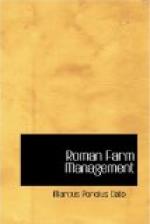“And justly so,” I exclaimed, “for his farms are a more pleasing spectacle to many on account of their clean cultivation than the stately palaces of others;[52] when one goes to visit his country place, one sees granaries and not picture galleries, as at the ‘farm’ of Lucullus.[53] Indeed,” I added, “the apple market at the head of the Sacred Way is the very image of Scrofa’s fruit house.”
As the new comers joined us, Stolo inquired: “Have we arrived after dinner is over, for we do not see L. Fundilius who invited us.”
“Be of good cheer,” replied Agrius, “for not only has that egg which indicates the last lap of the chariot race in the games at the circus not yet been removed, but we have not even seen that other egg which is the first course of dinner.[54] And so until the Sacristan returns and joins us do you discourse to us of the uses or the pleasures of agriculture, or of both. For now the sceptre of agriculture is in your hands, which formerly, they say, belonged to Stolo.”
“First of all,” began Scrofa, “we must have a definition. Are we to be limited in discussing agriculture to the planting of the land or are we to touch also on those other occupations which are carried on in the country, such as feeding sheep and cattle. For I have observed that those who write on agriculture, whether in Greek or Punic or Latin, wander widely from their subject.”
“I do not think that those authors should be imitated in that,” said Stolo, “for I deem them to have done better who have confined the subject to the straitest limits, excluding all considerations which are not strictly pertinent to the subject. Wherefore the subject of grazing, which many writers treat as a part of agriculture, seems to me to belong rather to a treatise on live stock. That the occupations are different is apparent from the difference in the names of those we put in charge of them, for we call one the farmer (villicus) and the other the herdsman (magister pecoris). The farmer is charged with the cultivation of the land and is so called from the villa or farm house to which he hauls in the crops from the fields and from which he hauls them away when they are sold. Wherefore also the peasants say vea for via, deriving their word for the road over which they haul from the name of the vehicle in which they do the hauling, vectura, and by the same derivation vella for villa, the farm house to and from which they haul. In like manner the trade of a carrier is called vellatura from the practice of driving a vectura, or cart.”
“Surely,” said Fundanius, “feeding cattle is one thing and agriculture is another, but they are related. Just as the right pipe of the tibia is different from the left pipe, yet are they complements because while the one leads, it is to carry the air, and the other follows, it is for the accompaniment.”




